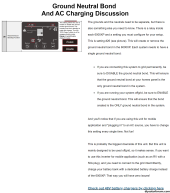HighTechLab
AKA Dexter - CTO of Current Connected, LLC
- Joined
- Sep 23, 2019
- Messages
- 1,691
Let's start with a snip from the EG4 6000XP manual.
What I'm getting at here, is a lot of people, including @Will Prowse in his latest video (8:03) are mistaken on how the 6000XP handles neutral and ground bonds. The inverter does NOT dynamically bond. This means that if you plan to put an cord and plug on the AC-input, then you will have problems (for example, if you plan to use this inverter in an RV). In my opinion, it's really only intended for hardwired applications, similar to the big-brother, the 18k-PV.
Neutral-ground bonds are critical in all modes of operation because it creates a fault current path so that you actually trip a breaker in the event of a ground fault. Without a neutral-ground bond, then all that happens during a ground fault is the cases of everything become live in relation to neutral and the fault is not cleared.
Double bonds are not acceptable by code or safe because it creates a parallel path for neutral currents. The current carried on the grounding conductor is know as objectionable current. NEC specifically addresses objectionable current.
The two options for successful and safe implementation are:
@Markus_EG4 Let me know if I've missed anything here.
What I'm getting at here, is a lot of people, including @Will Prowse in his latest video (8:03) are mistaken on how the 6000XP handles neutral and ground bonds. The inverter does NOT dynamically bond. This means that if you plan to put an cord and plug on the AC-input, then you will have problems (for example, if you plan to use this inverter in an RV). In my opinion, it's really only intended for hardwired applications, similar to the big-brother, the 18k-PV.
Neutral-ground bonds are critical in all modes of operation because it creates a fault current path so that you actually trip a breaker in the event of a ground fault. Without a neutral-ground bond, then all that happens during a ground fault is the cases of everything become live in relation to neutral and the fault is not cleared.
Double bonds are not acceptable by code or safe because it creates a parallel path for neutral currents. The current carried on the grounding conductor is know as objectionable current. NEC specifically addresses objectionable current.
The two options for successful and safe implementation are:
- Bond is either created upstream of the inverter, (in the main panel). Neutral and ground connections remain separate to the inverter (and any parallel connected inverters) and the relay in the inverter is left disabled). No cord-and-plug can be used between the main panel and the inverter. A hardwire connection is required so that the neutral and ground bond is maintained at all times, not just while plugged in.
- Bond is created in only one of the inverters, but there cannot be bonds upstream or downstream. This means if you decide to put a cord-and-plug, for example, an NEMA 14-50P (for an RV) or a 6-30P (for a generator), then you cannot plug the cord into a bonded system (for example, an RV park or generator with a bond). This would create a double-bond which is not permitted by code and cause objectionable current.
@Markus_EG4 Let me know if I've missed anything here.





